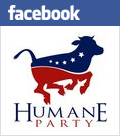Note To My Critics:
The links to the many sites that I've included contain information that I believe to be relevant, be it the graphics, the videos, the undercover investigations, etc. . Exposing & and ending the brutality and savagery inflicted on the non-human animals is what I am focused on. I strongly believe that every voice against animal abuse/exploitation is of value and -and- collectively we have the power to end it. I am here for the animals, not for anyone's approval and for that I make no apologies. ** I do not promote violence towards humans.
___________________________________________________

Friday, September 30, 2011
GREED
The greed of gain has no time or limit to its capaciousness. Its one object is to produce and consume. It has pity neither for beautiful nature nor for living human beings. It is ruthlessly ready without a moment's hesitation to crush beauty and life out of them, molding them into money.
-Rabindranath Tagore (1861–1941)
Posted by Denbeath at 2:01 PM 3 comments
Tuesday, September 20, 2011
It’s Time to Replace Animals in Harmful, Painful Experiments
Orignal Article Here: It%26%238217%3Bs+Time+to+Replace+Animals+in+Harmful%2C+Painful+Experiments
From: One Green Planet: http://www.onegreenplanet.org/
In late August I participated in a 4-day conference in Montreal. The 8th World Congress on Animals and Alternatives in the Life Sciences drew over 800, mostly scientists. The mission of the meeting was to advance “the 3Rs,” which aim to Replace, Reduce, or Refine (i.e., lessen the suffering of) animals used in research, testing, and education.
I mingled with people representing a wide range of viewpoints, from groups like Americans for Medical Progress and the New Jersey Association for Biomedical Research, whose mission is to defend the continued use of animals, to organizations dedicated to ending harmful uses of animals as soon as possible, like the Physicians Committee for Responsible Medicine, InterNICHE, PETA, AnimaLearn, and EuroGroup for Animals. My own paper, which used records obtained through the US Freedom of Information Act to chronicle the miserable lives of primates in two American laboratories, was one of several from The Humane Society of the United States.
Some of the presentations were stark reminders of just how sensitive animals are to the intrusions of humans on their lives. For example, just being transported to a new location was so stressful to caged rats that their body weight, heart rate and blood pressure aren’t back to normal two weeks after being moved, and their levels of activity and blood corticosterone (a hormone associated with stress) never returned to pre-move levels. A Canadian wildlife veterinarian presented data showing that the health of polar bears declines each time they are subjected to the stress of being captured (for study). The more times caught, the worse their physical condition becomes. The presenter asked his audience to imagine how stressed we would feel to be chased and caught by predatory aliens. Wild animals may struggle so hard to escape human capture that they are vulnerable to “capture myopathy,” irreversible muscular damage that can cause permanent lameness, even death.
But the great bulk of animal research is the kind done in laboratories. One of the sessions I attended focused on animal pain, with an emphasis on rodents. Disturbingly, pain research on animals is a thriving enterprise, and the past decade has seen a dramatic increase in research that deliberately subjects mice to unrelieved pain. All mammals process pain along the same neural and biochemical pathways, so it strikes me as a prejudice that rodents are commonly thought of as “lower mammals” whose pain and suffering is somehow less worthy of our concern. New studies further expose this prejudice. We saw video clips of mice being marked by having small holes punctured into their ears with a hand-held hole-puncher. This common laboratory method is routinely done without anesthesia. The mice squinted their eyes, opened their mouths wide and struggled violently in response to the assault. Rabbits having their ears pierced with a tattoo hole-puncher reacted similarly. The presenter told us he had the audio turned off so that we wouldn’t have to hear their screams. A video of a rabbit whose ear had simply been treated 20 minutes earlier with a topical anesthetic showed no pain response, and the presenter implored researchers to use this simple refinement.
Contrary to earlier belief, rodents and rabbits—which like many animals have evolved stoicism to avoid detection by predators—do show detectable pain on their faces and bodies. So reliable are these subtle pain responses that a research team has developed a Mouse Grimace Scale (MGS) that quantifies the severity of pain based on orbital tightening (eye closing), nose and cheek bulging and ear and whisker positions. A similar Rat Grimace Scale has since been developed. Even a complete novice can learn to recognize a rodent’s pain with just ten minutes of training.
I asked if a mouse’s pain might endure after grimacing stops. Yes, it’s fairly certain that it does. For example, we stop grimacing long before the pain of a sprained ankle or broken bone is gone. And yet, while human patients typically request and receive pain medication for 1 – 2 weeks following surgery, animals in laboratories (including the primates whose lab records I examined) typically get 1 – 2 days, and sometimes no pain relief at all.
This is all the more sobering considering that tens of millions of rodents are currently used in experiments, and a single research lab may have over 100,000 mice. I and a growing number of my scientific colleagues share the view expressed recently by the noted British biologist Richard Dawkins that “we have no general reason to think that non-human animals feel pain less acutely than we do.”
Some may conclude that the challenge is to reduce the pain and suffering of animals in labs. But I think this information demands another conclusion: we shouldn’t be using them at all, for the same reasons we don’t use humans.
Defenders of vivisection declare that animal research is “a necessity.” This is like saying that capital punishment is a necessity. Whatever one thinks of it, we are not bound to do it. We do it by choice, so we can choose not to. To me the most compelling reason to desist is that animals feel pain and suffer essentially like us. That being the case, there really is only one morally defensible “R”: Replacement.

Jonathan Balcombe was born in England and raised in New Zealand and Canada. He studied biology in Canada before earning a PhD in ethology (animal behavior) from the University of Tennessee. He is the author of three popular books on animals: Pleasurable Kingdom: Animals and the Nature of Feeling Good (2006), Second Nature: The Inner Lives of Animals (2010), and The Exultant Ark: A Pictorial Tour of Animal Pleasure (May 2011). Dr. Balcombe is the Animal Studies Department Chair for Humane Society University. In his spare time he enjoys nature-watching, biking, piano, vegan cooking and trying to understand his two cats. Dr. Balcombe is available as a environmental keynote and event speaker with Macmillan Speakers Bureau
Posted by Denbeath at 10:13 AM 3 comments
Sunday, September 18, 2011
Cows Enjoy Music
One of my Blogger Friends posted a link to this site and it impressed on me how the non-human animal responds to 'art' thought to be enjoyed only by Humans. Something to think about.
Posted by Denbeath at 1:18 PM 2 comments
Sunday, September 11, 2011
Saturday, September 3, 2011
Recipes: Vegan Pumpkin Spice Latte, Pumpkin Muffin, Vegan Icing, whipped Cream
Everyone who knows me knows that I'm a Vegetarian. Essentially I am the the family 'Eccentric', yeah, every family has one of their very own.....but I digress...
Anyway, here's a Pumpkin Spice Latte recipe that I tweaked to make it Vegan friendly: Now I realize that Organic Canned Coconut Milk is a bit pricey (or as my Scottish Husband would have said: 'Aye, that's dear') but since I don't buy meat I'm still ahead of the game as far as 'cost' is concerned. Also I sometimes find Roland Coconut Milk cheaper on amazon.com and usually shipping is free after you've hit the $25.00 mark.
Pumpkin Spice Latte
makes 1-2 servings
Ingredients:
2 cups Soy -or- Coconut -or- Almond milk
2 tablespoons canned pumpkin
2 tablespoons sugar or sugar substitute ( I like Agave Syrup) - you can halve this amount
2 tablespoons vanilla extract
1/2 teaspoon pumpkin pie spice
1/2 cup of strong brewed coffee (I've used Instant Coffee)
Directions:
In a saucepan combine milk, pumpkin and sugar and cook on medium heat, stirring, until steaming. Remove from heat, stir in vanilla and spice, transfer to a blender and process for 15 seconds until foamy. If you don't have a blender, don't worry about it - just whisk the mixture really well with a wire whisk.
Pour into a large mug or two mugs. Add the coffee on top.
***If you like whipped cream on your Latte:
Vegan Whipped Cream Recipe
1 Pack Silken Tofu
2 Tbsp Powdered Sugar
2 tsp Vanilla Essence
1/4 Can Organic Coconut Milk (I like the Roland Brand, Organic full fat)
When you open a can of coconut milk ( best if you chill the can in the fridge for an hour or so before opening) you will find thick creamed milk at the top of the can, scoop off the 1/4 of thick milk cream that you need for this recipe.
In a blender mix the sugar and silken tofu together.
Add the coconut cream and vanilla and blend into a smooth thick cream.
Ohhh....what to do with the leftover canned pumpkin? Why...Make Muffins of course!
Vegan Pumpkin Muffins
Ingredients
|
Directions
Preheat oven to 400°F. Lightly grease a twelve-muffin tin.
Sift together flour, sugar, baking powder, salt, and spices.
In a separate bowl, whisk together pumpkin, soy milk, oil,
and molasses. Pour the wet ingredients into the dry and mix.
Fill the muffin cups two-thirds full. Bake for 18 to 20 minutes,
until a toothpick or knife inserted in the center comes out clean.
What's a muffin without a decadent icing ?
Tofu Cream Frosting
Makes 1 1/3 cups (enough to frost one 9"x9" cake)
1 cup firm silken tofu (1/2 pound)
2 tablespoons oil
2 tablespoons fresh lemon juice
3 - 4 tablespoons maple syrup
1/4 teaspoon salt
1/2 teaspoon vanilla extract
Combine all ingredients in a blender and blend until very smooth. Scrape the sides of blender often with a rubber spatula to get the frosting completely smooth.
Per 2 1/2-tablespoon serving Calories: 65
ENJOY!!
Posted by Denbeath at 1:26 PM 3 comments
Labels: MUFFINS, PUMPKIN SPICE LATTE, VEGAN ICING, VEGAN RECIPES, VEGAN WHIPPED CREAM
Subscribe to:
Posts (Atom)














